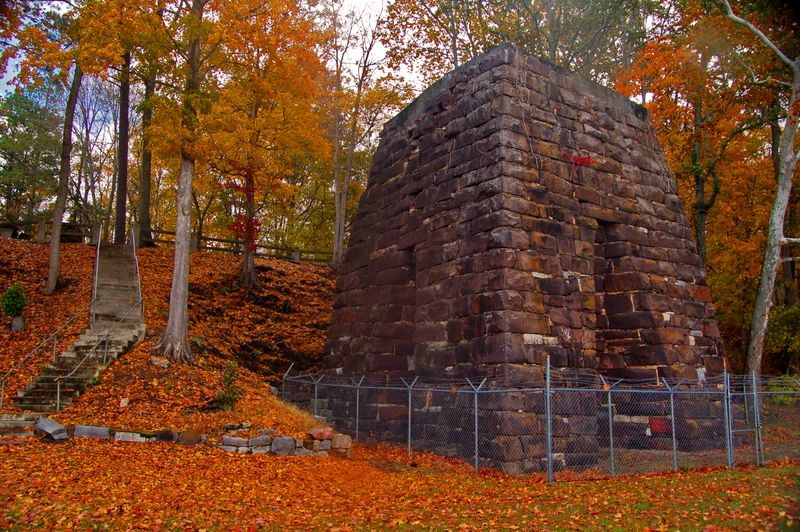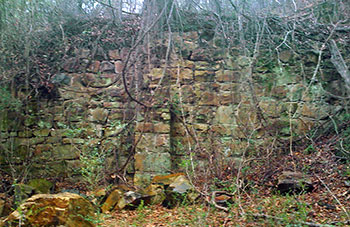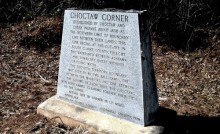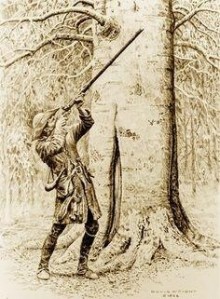A WAR TIME FOUNDRY
A Story of a Confederate Foundry at the present Anniston
By Kate Quintard Noble Roberts1
My Grandfather, James Noble, left England in 1837 and settled first in Pennsylvania, but wearying of the unfriendly climate, he became enamored of the Sunny South, and with his family, made his home in Rome, Georgia, in 1854. Continued below
In partnership with his sons, he set up the first foundry for building machinery and big engines in that section of the country, the only others being blacksmith shops for repairing plows, shoeing horses, etc.
In 1857 they constructed the Alfred Shorter, the first locomotive built south of the Mason and Dixon line.
Found land in Cherokee County, Alabama
When South Carolina seceded, they realized that war was inevitable and began to prepare for it. My Father and Grandfather were both fine mineralogists, and began looking for, and testing the iron ores. They found the ore they wanted, of just the right toughness in Cherokee County, Alabama, and bought a tract of land, which the owners were glad to dispose of— as it would grow neither corn, cotton nor wheat.
When the Confederate Government was organized and Jefferson Davis elected President, Noble Bros, were ordered to turn their shops to making of Ordnance. When Grandfather went to Montgomery to confer with President Davis about contracts for Ordnance, Davis instructed him not to let any of his sons enlist, saying he would get plenty of men to fight, but few who could make ordnance. If they disobeyed, he would have them taken out of the army and sent back to the works. Their product was mounted batteries of brass and iron howitzes on their caissons, tested and sent ready for battle.
There were no railways, no roads to the mines which had to be opened, no furnace to make the iron— all that had to be done
Furnaces built on the Chattago
They built their furnaces on the Chattago River which flows into the Coosa at this point, making a horseshoe curve. A canal was dug across it, the furnace and a large flour mill built at one end and a small sawmill at the other. A tunnel was dug under a hill and the furnace run by water power.
The canal was dug by farmers, tenant farmers; enlisted men having permits from the Government, and they were glad to work there, as they could look after their families and not be drafted, being already in the service. There was an army of workers, miners, colliers, canal diggers, farmers, teamsters, horses, mules, and wagons, all assembled at Cornwall—the furnace named for Grandfather’s native country in England, and all having to be looked after.
Cornwall Furnace
1200 County Road 251, Cedar Bluff, Alabama 35960 USA

The ore was hauled on wagons to the furnace where it was beaten with heavy hammers until small enough to be melted in the furnace. The negroes, both men and women, sat on the ground, breaking the ore and singing continuously. At night they had revivals, got religion, and sang until mid-night. The only other furnace near was a small one making only a ton a day.
No record of guns bursting
When the pigs were run, they were hauled to Cedar Bluff, (the furnace was between Cedar Bluff and Gaylesville) and shipped to Rome by steamboat. There were two of these, the Cherokee and the Alfaretta, Noble Brothers being the principal stockholders. The foundries were on the bank of the river in Rome, near its junction with the Oostknaula to form the Coosa.
The iron being very tough, made fine guns. It was delivered there, cast into cannon, mounted on their carriages, and sent to their destination. When you realize that it had to be made from the ore with no crushers, limestone, etc., the most crude and primitive makeshifts, transportation by ox and mule teams over long and bad roads, the rapidity with which they were made and shipped was marvelous, and there is no record of a gun bursting.
Gen. Gorgas tested the cannon
Gen. Gorgas was chief of Ordnance and came often to Rome to test the cannon, and as there was no hotel, he stayed at my Grandfather’s home, and one of the rooms was called Gen. Gorgas’ room.
I have spoken of the iron batteries. The shops also made many brass howitzers. The shopyards were a wonderful sight with loads of stills and their worms from fifty to hundreds of gallons, bells from churches, brass and iron fenders, candlesticks and other heir looms given cheerfully by the farmers. Then every farmer and his still was a matter of course, and his peach and apple orchard. There was no San Jose scale or apis or borers, and he made his own peach and apple brandy, drank what he made and treated his friends and neighbors.
Drawings of a machine to make bullets were sent by the Tredegar Iron Works of Richmond, Va., to a firm in New Orleans. There was something wrong with the drawing, and Tredegar could not make it work. They sent drawing to Noble Brothers. Uncle John found the flaw, corrected it, made the machine and the machine made bullets. Uncle Jim made a rifle for the guns which the firm used. He afterwards tried to get a patent for it, but there was so much delay and so many calls for more money that he became disgusted and let it go.
Federal Forces destroyed the furnace
In June 1864 Gen. Frank Blair’s 17th Army Corps came down like a wolf on the fold. They burned the furnace, cut cloth from the looms, took all the pillow cases to carry off hams and poultry, all the men’s underwear, milk from the dairy,—even the fish just cleaned for supper. There were gates to the canal to turn the water off and on, and sometimes the canal was drained and all were allowed as much fish as they wanted.
The Federal Forces blew up the tunnel through which the river ran the furnace, destroyed the furnace, gathered together all the wagons and carts, stacked them against the stable and set fire to the whole thing. The horses and mules they took with them though some had been run off and hidden. However, when Sherman marched to the sea, he got what was left.
Took my father and grandfather with them
Uncle Stephen, then a boy of sixteen, ran the steamboat below the shoals near Guntersville and they could not get it—that is, the Federals, but Uncle Stephen afterwards did.
My Father had been captured before this when, in Tennessee hunting supplies for his workmen. He managed to communicate with our Uncle in Pennsylvania and obtained his release. When Rome was occupied by the Federal troops in October 1864, he came back, but the foundries were burned to the ground. The house was saved by having several officers quartered there, who were regaled by the “Bonnie Blue Flag” and “The Homespun Dress” and my five rebel Aunts. The troops stayed in Rome about six months, and took my father and grandfather with then when they left.
With everything burned to the ground and desolation a]l around—in seven years the foundries were rebuilt, their product known all over the country, and Noble Brothers had built the Rome Waterworks and were making the engines for the furnace that was the beginning of Anniston.
The following is from a newspaper printed in 1927:
“OLD IRON FURNACE NEAR GADSDEN-THAT AIDED CONFEDERACY-DOOMED”
Gadsden, Ala., Jan. 17th, 1927: ‘Modern industry in the shape of the Eureka Foundry in Gadsden has just accomplished what the fiercest civil war in history and 75 years of time failed to do, by completely dismantling and demolishing the old Round Mountain Furnace at Round Mountain, in Cherokee County. Every scrap of iron left about the old plant is being put on board cars and shipped to this City, where it will be melted into all sorts of commercial castings.
Round Mountain Furnace

The Round Mountain Furnace was built more than 75 years ago. Some say it is 100 years old. At any rate it is one of the oldest in the country-or was one of the oldest, for it is being wiped out completely. In the sixties its destruction was greatly desired by the Federal army because it was furnishing the iron from which the Noble Bros. Iron Works at Rome, Ga., was making canons for the Confederate Army. The iron was hauled by wagon to the river at Round Mountain and was delivered to Rome by steamboat. It was weighed on the furnace yard by a specially built grasshopper scale, similar to those used in weighing cotton then and now.
“General Straight, the Federal raider, was sent into this part of the country with a picked army to destroy the furnace at Round Mountain, and the Noble foundry at Rome. He succeeded in partially burning the furnace, but was captured by Gen. Nathan Bedford Forrest at the gate of Rome.
“The old stack was rebuilt immediately and was operated until something like 25 or 30 years ago. It had the reputation of making the finest car wheel iron in America. The great Baldwin Locomotive Works at Philadelphia used it for tender wheels, and for pony wheels on locomotives. It is tough and presented a hard wearing surface.
CHARGED WITH CHARCOAL
“The Eureka Foundry Company of which Even J. Owen is proprietor recently purchased the old plant and its 40-acre tract. The stack was built at the foot of the mountain and wagons loaded with ore drove to the top of the mountain and dumped their load into the stack. It was charged with charcoal and ore in that way from the day it started-until it was abandoned.
“Mr. Owen said Monday that while knocking around the old wreck he came across a brass plate on which were the words, “Noble Iron Works, Rome, Ga.” This plate was on the blowing engine which was built by the Noble Brothers. They also built the engines and all other machinery for the Etna, the Cornwall and the Rock Run Furnaces.”
1*Mrs. E. E. G. Roberts, of Anniston, is the eldest daughter of Mr. Samuel Noble, co-founder of the town of Anniston
SOURCE
- The Alabama Historical Quarterly, Vol. 18, No. 04, Winter Issue 1956





Good article
This is in our backyard. Cherokee County residents read this.
My husband is a Noble and I wondered where they came from. Wonderful information.
My husband is a Noble and I wondered where they came from. Wonderful information. Thank you very much.